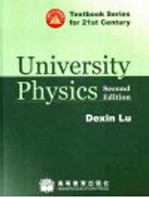图书介绍
大学物理学 第2版PDF|Epub|txt|kindle电子书版本网盘下载

- 卢德馨编著 著
- 出版社: 北京:高等教育出版社
- ISBN:7040118467
- 出版时间:未知
- 标注页数:566页
- 文件大小:23MB
- 文件页数:584页
- 主题词:
PDF下载
下载说明
大学物理学 第2版PDF格式电子书版下载
下载的文件为RAR压缩包。需要使用解压软件进行解压得到PDF格式图书。建议使用BT下载工具Free Download Manager进行下载,简称FDM(免费,没有广告,支持多平台)。本站资源全部打包为BT种子。所以需要使用专业的BT下载软件进行下载。如BitComet qBittorrent uTorrent等BT下载工具。迅雷目前由于本站不是热门资源。不推荐使用!后期资源热门了。安装了迅雷也可以迅雷进行下载!
(文件页数 要大于 标注页数,上中下等多册电子书除外)
注意:本站所有压缩包均有解压码: 点击下载压缩包解压工具
图书目录
CONTENTS1
Chapter 1 Introduction1
1.1 What is physics1
1.2 Physical quantities4
1.3 Appfoximation in physics8
1.4 Vectors10
1.5 Orthogonal coordinate systerms14
Problems17
References19
Part One Mechanics25
Chapter 2 kinematics25
2.1 Mechanical motion and moving object25
2.2 Translation26
2.3 Rotation29
2.4 Oscillation32
2.5 Phase space35
2.6 Galilean ttansformation36
2.7 Coriolis accelemtion37
Problems40
References41
Chapter 3 Particie Dynamics42
3.1 The law of inertia and inertial frame of reference42
3.2 Newton's second and third laws43
3.3 Forces47
3.4 Noninertial frame of reference and inertial force50
3.5 Momentum and angular momenturm52
3.6 Mechanical work and energy54
Problems58
References59
Chapter 4 Gravitafion60
4.1 The law of gravitation60
4.2 Gravitational potential energy65
4.3 Gravitational mass,redshift,and collapse71
4.4 Kepler problem and scattering76
4.5 Gravitational field80
Problems85
References87
Chapter 5 Dynamics of Many-Particle System88
5.1 The center of mass88
5.2 System with variable mass93
5.3 Collisions94
5.4 Fluid motion101
5.5 Symmetry and conservation laws104
Problems105
References107
Chapter 6 Dynamics of a Rigid Body108
6.1 Rotational inertia108
6.2 The dynamics of rotation111
6.3 Precessjon of angular momentum114
6.4 Equilibrium of rigid bodies and stability115
Problems118
References119
Chapter 7 Oscillations120
7.1 Simple harmonic motion120
7.2 Coupled oscillation124
7.3 Damped oscillation127
7.4 Nonlinear oscillation129
7.5 Forced oscillation under friction131
Problems134
References135
Chapter 8 Waves136
8.1 Waves and their classification136
8.2 Wave equation137
8.3 Simple harmonic waves and their superposition140
8.4 Interference and diffraction147
8.5 Dispersion and wave packet149
8.6 The Dopplere effect151
8.7 Solitary wave152
Problems153
References155
Chapter 9 Relativistic Mechan-cs156
9.1 Galilean transformations156
9.2 The Lorentz transformations160
9.3 Spacetime diagram and twin paradox165
9.4 Relativislic kinematics168
9.5 RelatiVistic dynamics170
Problems176
References178
Part Two Thermal Physics182
Chapter 10 Temperature182
10.1 Equilibrium state182
lO.2 Thermal equilibrium and temperature184
10.3 EmpiricaI temperature scales184
10.4 The equation of stare186
References189
Problems189
Chapter 11 The First Law of Thermodynamics190
11.1 Work and internal energy190
11.2 Heat and the first law of thermodynamics192
ll.3 Heat capacity and specific heat193
11.4 Free expansion and intemal energy of gas196
11.5 Adiabatic equation198
11.6 The Camot cycle199
Problems200
References202
Chapter 12 The second Law of Thermodynamics203
12.1 The second Iaw203
12.2 Carnot theorem and thermodynamic scale204
12.3 Entropy and entyopy principle206
12.4 Thermodynamic potentials211
12.5 Relativistic thermodynamics215
12.6 Blackhole thermodynamics217
Problems218
References220
Chapter 13 Microscopic Model of Ideal GaS221
13.1 Ideal gas221
13.2 Equilibritum distribution224
13.3 Equipartition theorem227
13.4 Effusion228
13.5 Transport phenomena230
Problems236
References237
Chapter 14 Phase Transition238
14.1 Van der Waals equation238
14.2 Phase and phase diagram240
14.3 Clapeyron's equation241
14.4 Higher order phase transition244
14.5 Concepts in modern theory of phase transition246
Problems248
References250
Part Three Electromagnetism253
Chapter 15 EIectrostatic Field253
15.1 Electric charge and Coulomb's law253
15.2 Electrostatic field257
15.3 Gauss'law261
15.4 Electric potential 266
15.5 Electric potentia1 energy269
Problems274
References275
Chapter 16 Conductor and Dielectrics277
l6.1 Uniform conductor in an electrostatic field277
16.2 Capacitance279
16.3 Conductivity and Ohm's law282
l6.4 Dielectrics284
16.5 Electric vectors285
Problems289
References290
17.1 Magnetic field291
Chapter 17 Magnetic Field291
17.2 Ganss'law for magnetism and Ampere'slaw296
17.3 Magnetic force298
17.4 The Hall effect304
Problems306
References307
Chapter 18 Electromagnetic Induction308
18.1 Faraday's law of induction308
18.2 Motional EMF311
18.3 Inductance313
18.4 Relativity of E and B318
Problems320
References322
Chapter 19 Magnetic Properties of Matter323
19.1 Magnetic dipole of microscopic particles323
19.2 Magnetic vectors328
19.3 The magnetic propenies of macroscopiC objects331
19.4 The magnetism of the earth335
Problems336
References337
Chapter 20 Maxwell's Equations338
20.1 Quasi-equations and monopole338
20.2 Displacement current and induced magnetic field 34l20.3 Differential form of Maxwell's equations345
20.4 Energy flow and field momentum density346
ProbIems348
References349
21.1 Wave equations350
Chapter 21 Electromagnetic Waves350
21.2 Travelling waves352
21.3 Radiation354
21.4 Crystal djffraction356
21.5 Standing wave alld DOS357
Problems358
References359
22.1 Blackbody radiation363
Part Four Fundamental Modern Physics363
Chapter 22 Energy Quantization363
22.2 The photoelectric efiect366
22.3 The Compton Effect369
22.4 Line spectra the energy quantization in atoms370
Problems374
References375
Chapter 23 Wave Nature of Matter376
23.1 Matter waves376
23.2 Davisson-Germer experiment377
23.3 Electron two-slit experiment378
23.4 Uncertainty relation379
Problems382
References382
Chapter 24 Schrodinger Equation383
24.1 The wave function383
24.2 Schrodinger equation383
24.3 One dimensional potential well386
24.4 Potential barrier387
24.5 Simple harmonic oscillator391
Problcms394
References395
Chapter 25 Atoms396
25.1 The hydrogen atom396
25.2 Energy level and transition397
25.3 Probability density400
25.4 Orbital angular momentum and spin402
25.5 Many-electron atoms405
25.6 Lasers406
25.7 Xrays408
Problems410
References410
Chapter 26 Molecules and Clusters411
26.1 Atomic orbital411
26.2 Molecular orbital414
26.3 Ionic bonding417
26.4 Molecule vibrtion and rotation419
26.6 Clusters424
Problems425
References426
Chapter 27 Fermi and Bose Statistics427
27.1 Fermions and Bosons427
27.2 Fermi-Dirac distribution429
27.3 Bose-Einstein distribution photon gas430
27.4 Bose-EinStein Condensation431
27.5 Specific heat of solids434
Problems437
References438
Chapter 28 Condensed Matter439
28.1 Spatial orders in condensed matter439
28.2 Hausdorff dimension and fractal442
28.3 Bonds in crystals443
28.4 Free electron model for metals446
28.5 Energy band447
Problems448
References449
Chapter 29 Nuclear Physics451
29.1 Atomic nucleus451
29.2 Nuclear force and nuclear models454
29.3 Radioactive decays457
29.4 Mossbauer effect462
29.5 Fission and fusion463
Problems469
References471
Chapter 30 Leptons and Quarks472
30.1 Particles and their classification472
30.2 Interactions476
30.3 Conservation laws479
30.4 Quarks481
30.5 The CPT theorem482
Problems485
References487
Chapter 31 Astrophysics488
31.1 Structure and evolution of stars488
31.2 White dwarfs489
31.3 The neutron stars and pulsars491
31.4 Quasar493
31.5 Blackhole and primordial blackhole494
Problems497
References498
Chapter 32 Physical Cosmology499
32.1 Basic facts and cosmological principle499
32.2 Basic concepts502
32.3 Curved spacetime and metrics505
32.4 Gravitational field equation508
32.5 Dynamics of the standard model511
32.6 Progress in cosmology514
Problems515
References515
Appendix519
A Commonly used Physical Constants519
B Simple Pendulum and Jacobi's Elliptical Function522
C Critical and Heavy Damping524
D Fourier Series and Frequency Spcctrum526
E Inlegral Results about Packets529
F Planets in Solar System532
G Gaussian Integral and Gamma Function533
H Operator535
I Dirac Delta Function538
J Riemann Zeta Function539
K Wave Functions540
L Relativistic Transformation of Electromagnetic Field542
Answers to Odd-Numbered Problems546
Index554